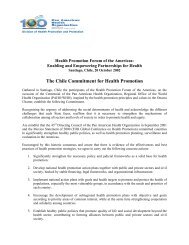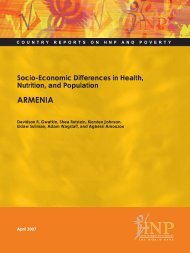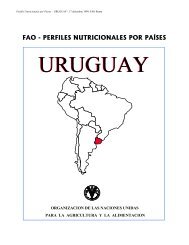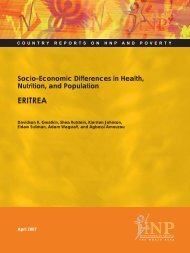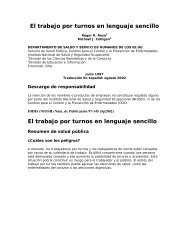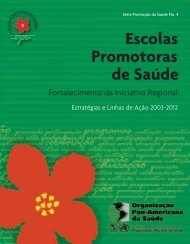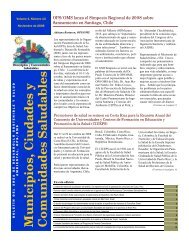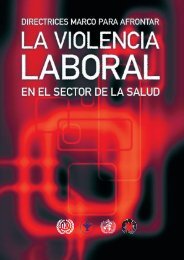Guidelines for drinking-water quality. Volume 1 - BVSDE
Guidelines for drinking-water quality. Volume 1 - BVSDE
Guidelines for drinking-water quality. Volume 1 - BVSDE
You also want an ePaper? Increase the reach of your titles
YUMPU automatically turns print PDFs into web optimized ePapers that Google loves.
additional cancer per 100 000 of the population ingesting <strong>drinking</strong>-<strong>water</strong> containing the substance<br />
at the guideline value <strong>for</strong> 70 years). Concentrations associated with estimated excess lifetime<br />
cancer risks of 10 -4 and 10 -6 can be calculated by multiplying and dividing, respectively, the<br />
guideline value by 10. These values are also presented in this volume to emphasize the fact that<br />
each country should select its own appropriate risk level. In cases in which the concentration<br />
associated with a 10 -5 excess lifetime cancer risk is not practical because of inadequate analytical<br />
or treatment technology, a provisional guideline value was set at a practicable level and the<br />
estimated associated cancer risk presented.<br />
Although several models exist, the linearized multistage model was generally adopted in the<br />
development of these guidelines. As indicated in <strong>Volume</strong> 2, other models were considered more<br />
appropriate in a few cases.<br />
It should be emphasized, however, that guideline values <strong>for</strong> carcinogenic compounds computed<br />
using mathematical models must be considered at best as a rough estimate of the cancer risk.<br />
These models do not usually take into account a number of biologically important considerations,<br />
such as pharmacokinetics, DNA repair, or immunological protection mechanisms. However, the<br />
models used are conservative and probably err on the side of caution.<br />
To account <strong>for</strong> differences in metabolic rates between experimental animals and humans - the<br />
<strong>for</strong>mer are more closely correlated with the ratio of body surface areas than with body weights - a<br />
surface area to body weight correction is sometimes applied to quantitative estimates of cancer<br />
risk derived on the basis of models <strong>for</strong> low-dose extrapolation. Incorporation of this factor<br />
increases the risk by approximately one order of magnitude (depending on the species upon<br />
which the estimate is based) and increases the risk estimated on the basis of studies in mice<br />
relative to that in rats. The incorporation of this factor is considered to be overly conservative,<br />
particularly in view of the fact that linear extrapolation most likely overestimates risk at low doses;<br />
indeed, Crump et al. concluded that “all measures of dose except dose rate per unit of body<br />
weight tend to result in overestimation of human risk.” 1 Consequently, guideline values <strong>for</strong><br />
carcinogenic contaminants were developed on the basis of quantitative estimates of risk that<br />
were not corrected <strong>for</strong> the ratio of surface area to body weight.<br />
1 Crump K, Allen B, Shipp A. Choice of dose measures <strong>for</strong> extrapolating carcinogenic risk from<br />
animals to humans: an empirical investigation of 23 chemicals. Health physics, 1989, 57,<br />
Suppl. 1: 387-393<br />
3.5 Mixtures<br />
Chemical contaminants of <strong>drinking</strong>-<strong>water</strong> supplies are present with numerous other inorganic and<br />
organic constituents. The guideline values were calculated separately <strong>for</strong> individual substances,<br />
without specific consideration of the potential <strong>for</strong> interaction of each substance with other<br />
compounds present. However, the large margin of safety incorporated in the majority of guideline<br />
values is considered to be sufficient to account <strong>for</strong> potential interactions. In addition, the majority<br />
of contaminants will not be present at concentrations at or near their guideline value.<br />
There may, however, be occasions when a number of contaminants with similar toxicological<br />
effects are present at levels near their respective guideline values. In such cases, decisions<br />
concerning appropriate action should be made, taking into consideration local circumstances.<br />
Unless there is evidence to the contrary, it is appropriate to assume that the toxic effects of these<br />
compounds are additive.<br />
3.6 Summary statements<br />
3.6.1 Inorganic constituents




